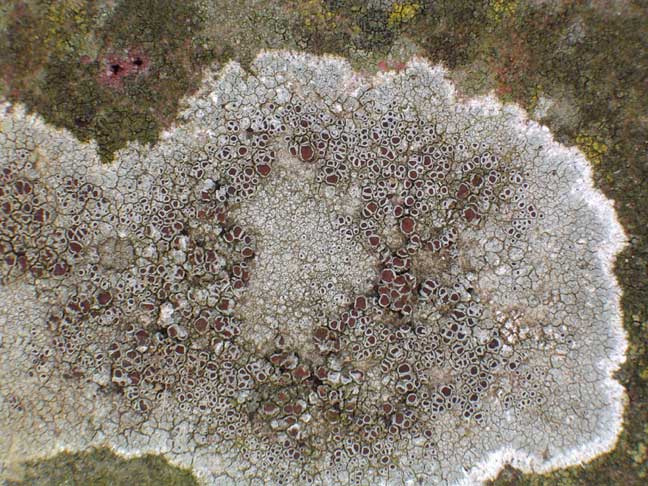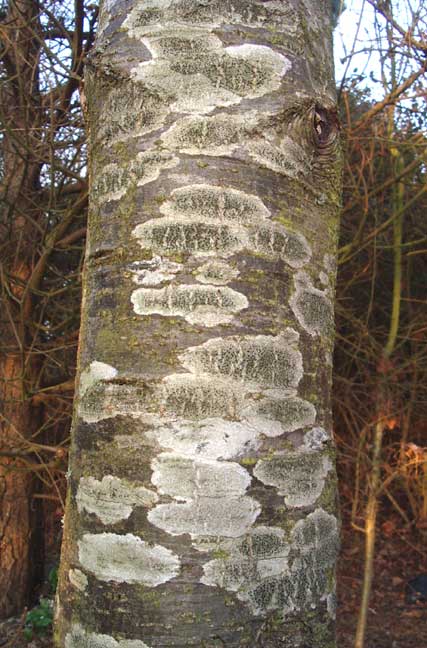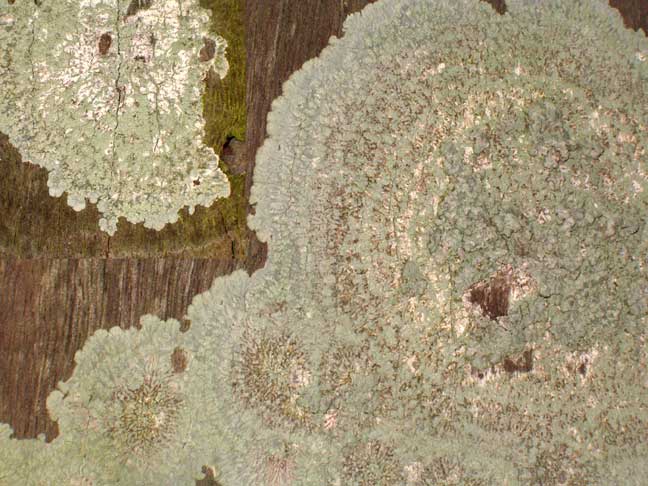Lichens
on a Blackthorn
Old
Shoreham
Lichens
on a Blackthorn
Old
Shoreham
10 May 2008
This small moth flew into the shade. The lichens were on the chestnut fencing of the Pixie Path to Mill Hill.
2 March
2006
 |
 |
 |
| Recorded on a branch of a small tree (species not noted) in the Maple Spinney footpath at the south end of the Waterworks Road, Old Shoreham | On the chestnut fencing struts, on the Pixie Path (west-east, middle section) to Mill Hill | On the chestnut fencing struts, on the Pixie Path (west-east, middle section) to Mill Hill |
18
January 2006
 |
 |
 |
 |
 |
 |
 |
One
tree on the upper slopes of Mill Hill sported
at least four of the common local lichens. The images are from two separate
trees.
 |
13
January 2006
There appears to be new growths of the Cladonia Pixie Cup Lichens on the broken chestnut fencing at the top of the Pixie Path by the tall garden hedge. The green leaves are called "squamules" from which the "podentia" grow. I am not sure of the identity of these lichens without the reference but they could be Cladonia coniocrae. |
This
lichen was on a damp branch on the Waterworks
Road. I think this may be identical to a light coloured green specimen
photographed
below and has gone dark green because of the water.
18
March 2005
 |
 |
 |
 |
Lichens (photographed above) on fallen fences next to the Pixie Footpath adjacent to the horse fields on the way to Mill Hill,
16
March 2005
 |
 |
 |
|
|
|
ID by Jenny Seabright |
|
Lichens
(photographed above) on fallen fences next to the Pixie
Footpath adjacent to the horse fields
on the way to Mill Hill, proved difficult
because of their small size and their apparent preference for the shade.
Pixie
Cups and other epixylic organisms
(Local Link)
March
2005
 |
 |
 |
Lichens (above) on the headstones
of St. Mary de Haura Church, New Shoreham.
 |
 |
 |
|
| Lichen on an Oak in Buckingham Park, Shoreham | Lichens on concrete between
Botolphs and the River Adur
|
Lichens on a tree near Beeding Cement Works, next to the cyclepath |
Cuckoo's
Corner Lichens (Link)
River
Hulk Lichens

12-13
February 2005
In
passing I made a cursory look at the lichens in St. Mary de Haura Churchyard,
Shoreham, but there only seemed to be the yellow Xanthoria
lichens
and
the grey-blue-white species illustrated below. In addition there
was a white species that could be mistaken for render on a flint wall.
It is frequently found on brick garden walls in the green parts of town
and is photographed on the right. This could be Lecanora
dispersa ? which is the commonest
lichen in Britain. This
looks like it could be identical to the grey-blue-white
lichen.
8
February 2005
 |
 |
 |
With
very little of natural interest, I took a closer look at the lichens
on the trees and bushes of Mill Hill. The
pictures above show the lichens of most interest. The ones with the miniature
black tar-like globules in the photographs were not seen before in Shoreham
town, but I may have overlooked them. They are probably a reasonably common
species. These lichens were photographed on Italian
Alder but were to be found
on the Hawthorn
as well. The lichen
on Hawthorn is
possibly a different species.
Mill
Hill Lichen Report
 The
yellow Xanthoria lichens decorate
or mar (depending on your taste) the appearance of roof tiles throughout
the district and I daresay throughout Sussex and England as well.
The
yellow Xanthoria lichens decorate
or mar (depending on your taste) the appearance of roof tiles throughout
the district and I daresay throughout Sussex and England as well.
On the path leading to Mill Hill, I noted and photographed a few lichens, mosses and other growths on wood. The photograph on the right shows the podentia of a Cladonia Pixie Cup Lichen.
30
January 2005
The
following lichens were recorded on trees in Buckingham Park, Shoreham.
 |
 |
 |
23
January 2005
The
grey-white
lichens were found on the sandstone rock
garden and stream by the garden pond of the back garden of 40 The Drive
(near Buckingham Park), (TQ 219 063)
and
are common on walls in The Drive, Shoreham. There may be more than one
species of grey lichens. This could be the genus
Lecanora
campestris.
I am unsure about the species.
 |
 |
The yellow Xanthoria lichens were also present but were most often to be seen on the roof tiles of the houses.
6 January
2005
 |
 |
This
greyish-blue coloured lichen is common on walls in the town centres, even
walls built only 30 years ago. The photographs were taken on the flint
wall surrounding Hove (East Sussex) Cemetery at the PC World (eastern)
boundary.
This could be Pertusaria which was photographed on a tree a year ago. |
5
January 2005
I
did not have my close-up spectacles on and although there appeared to be
two lichens on the same Hawthorn
tree as below, I did not wade through the mud to examine the species (photographed
on the right) under a magnifying glass. The
greeny-yellow species appears to be Flavoparmelia caperata,
and the silvery-bluish lichen is not really clear enough for a positive
identification. It is possibly the species Parmelia
laevigata,or is it Physcia? Or could it be Lecanora
sp.?
| These lichens were discovered on a Hawthorn tree on the Spring Dyke by Miller's Stream. The lichens may or may not have been stripped from the bark. One branch was damaged, probably by machinery that cuts down the reeds in late autumn, but possibly by Roe Deer. |  |
 |
 |
My inexperienced identification is the species Flavoparmelia caperata (=Parmelia).
4 January
2005
 |
 |
|
(may be the same genus but a different species?) |
Click on the image for colour corrected images |
The wooden fence separating the shingle from the concrete promenade has probably been there for over fifty years. There are two common and distinctive lichens growing well above high tide limit (in air laden with salt spray in the breeze that was steady Force 6 gusting to gales, with white crests to the foamy sea waves breaking up to a metre in height) and these were the yellow and blue-green species illustrated above.
Mid-December
2004
The
lichen Ramalina farinacea
photographed by Ray
Hamblett on Lancing Ring is a species
only be to be found in areas of low pollution.
NB:
This does not actually seem to be entirely the case as the lichen has been
seen by me near very busy road embankments (e.g. the Pixie
Path next to the Mill Hill Cutting, Old Shoreham).
 |
 |
|
Physcia Malthouse Meadows, Lancing |
Xanthoria parietina : a very common species On the sunny side of Sycamore trees immediately north of the Hamm, Shoreham town |
 |
 |
|
|
Xanthoria parietina Lichens covered the branches of the Elderberry Trees on the footpath approach to Mill Hill from the Waterworks Road |
Close-up (click) Under Field Maple, near the Waterworks Road |
|

4 January
2004
|
 |
 |
20
May 2003
Xanthoria sp. |
Recommended ID reference sources:
Lichens
by Dobson, Frank
S.
Published Price: £30.00
ISBN: 0855461454
Edition: 3r.e.of
"Lichen
Published by: Richmond Pub.Co.
Publication Date: 01 March 1992
http://www.countrybookshop.co.uk/books/?whatfor=0855461454
Lichen Identifier: A Multi-Access
Key to the Lichens of Great Britain and Ireland
Frank S Dobson
48 pages, dist maps, 400
col photos.
Frank S Dobson
This is a simple to use multi-access
computer key that enables the user to find the species name of any British
or Irish lichen. It is divided into field and microscopical characters
and any information available may be entered in any order to obtain a solution.
With the majority of species, a few characters, noted in the field, are
sufficient to identity the species.
A brief note on each species
further assists separation of similar species.
http://www.nhbs.com/xbscripts/bkfsrch?search=142754
http://www.thebls.org.uk/l-i.htm